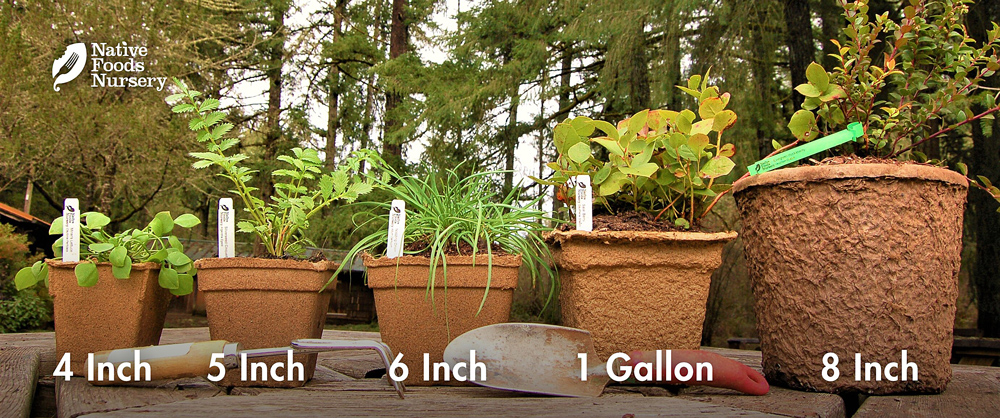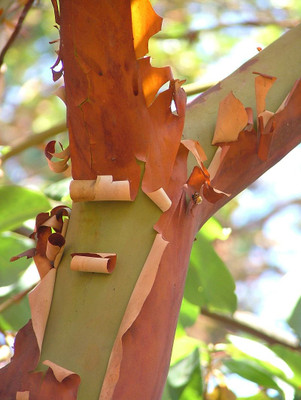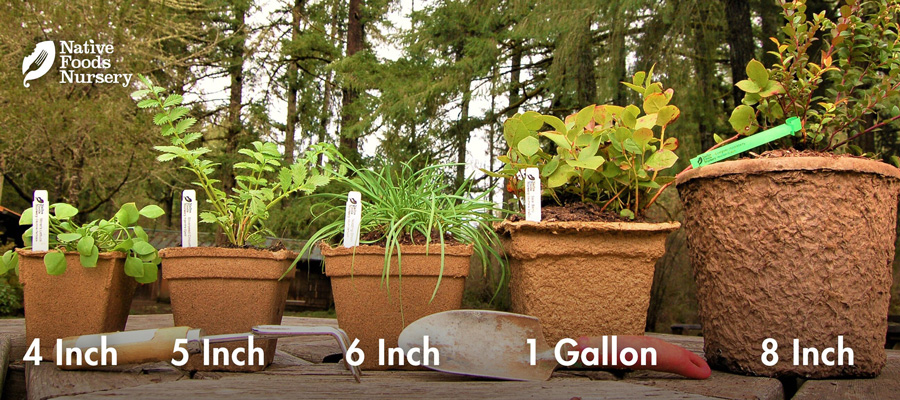Pacific Madrone


- Current Stock:
- 0
- Other Names:
- Madrona, Laurelwood, Oregon Laurel, bo’da (Pomo, pronounced "BOH-dah")
- Latin Name:
- Arbutus menziesii
Pacific Madrone—also called Madrona—is a prized Northwest evergreen with peeling cinnamon bark, urn-shaped white spring blossoms, and red–orange fall berries that feed birds and can be used in the kitchen [1][2][7].
Edible and Medicinal Uses
Madrone berries are edible but can be astringent—eaten fresh in small quantities, cooked, dried, or brewed into a cider-like beverage [4][5]. Flavor varies by site and season; many foragers harvest when berries are deep red in cool fall weather and process (cook/dry) to mellow tannins. Use fresh, or cook into compotes and leathers, or dry and grind into a spice-like powder for winter baking [4][7]. In regional traditions, madrone bark tea is used for colds and sore throats, and leaf preparations serve as astringent washes for minor ailments [4][5]
Our favorite is to make a compote, jar it, and then use it in any number of dishes over the Winter (see our recipe here).
Ornamental Qualities
The mosaic bark peels to reveal green and copper layers, contrasting with glossy evergreen leaves and clusters of white, bell-shaped flowers. Winter berry clusters add color and wildlife value, while the sculptural branching gives four-season interest in naturalistic gardens [2][7][10]. Consider pairing with other dry-summer, well-drained, mostly acid-loving natives. Salal and Evergreen Huckleberry provide complimentary evergreen understory. Tuck Red-Flowering Currant just beyond the dripline for an early-spring nectar source.
Environment and Culture
Ranging from British Columbia to California (locally to Baja), mostly west of the Cascades, Pacific Madrone occupies rocky slopes, bluffs, and open woods from sea level to ~100–1500 m [2][8][9][11]. After fire it’s commonly top-killed but resprouts from a burl/lignotuber, a key survival trait in dry, fire-prone landscapes [3].
Indigenous communities across the region continue to harvest and tend madrone as living food and medicine: berries eaten fresh/dried or made into cider; bark tea for colds/sore throats; leaves chewed or used medicinally in household practice. Honoring these ongoing relationships respects knowledge that sustains both people and place [4][5].(Learn more & how to help on our Charitable Giving page.)
Harvest, Care, and Preparation
Planting: Transplant small stock only; madrone dislikes root disturbance. Choose full sun to light shade with excellent drainage (rocky/sloping sites ideal) [6][10].
Water: Water to establish, then minimal/no summer irrigation in native-range climates to reduce root diseases; keep soils on the dry side thereafter [6][10].
Maintenance: Avoid heavy mulch against the crown; prune lightly for clearance only.
Harvest: Pick ripe, deep-red berries in autumn; process promptly—cook, dry, or brew—for best flavor and storage [4][7].
(More details in our Planting Guide in the next tab)
Attributes
Native Range: British Columbia to California (locally to Baja); chiefly west of the Cascades [2][9][11]
USDA Zones: 7–10 (coastal/maritime climates) [1][7]
Ease of Care: Moderate; best success with small transplants and excellent drainage [6][10]
Deer Resistance: Moderate (protect young shoots)
Light Requirements: Full sun to light shade [2][7]
Soil Type: Well-drained, rocky or sandy loam; avoid compacted/wet soils [10]
Water Requirements: Low after establishment; minimal/no summer irrigation in native range [6][10]
Pollination: Self-fertile [2]
Bearing Age: ~5+ years from establishment (site dependent)
Size at Maturity: ~25–60 ft (occasionally larger in optimal sites) [7][9]
Plant Spacing: 10–20 ft (allow for broad crown)
Bloom Time: Spring (April–June, peak May) [2]
Harvest Time: Autumn (Sep–Dec; persists into early winter) [7]
References
[1] USDA PLANTS Database. Arbutus menziesii (Pacific madrone). U.S. Department of Agriculture, Natural Resources Conservation Service.
[2] Flora of North America Editorial Committee. Arbutus menziesii Pursh. In: Flora of North America North of Mexico, Vol. 8 (Ericaceae).
[3] Fire Effects Information System (FEIS). Arbutus menziesii — Fire ecology and management. U.S. Forest Service, Rocky Mountain Research Station.
[4] USDA NRCS Plant Guide. Arbutus menziesii (Pacific madrone) — Uses and ethnobotany.
[5] National Park Service. Pacific madrone — Ethnobotany notes (berries, bark tea, leaf uses).
[6] Oregon State University Extension. “Native madrones are special to the Northwest” — establishment and transplant guidance.
[7] Washington State University, Ornamental Plant Pathology. “About Pacific Madrone” — landscape notes, fruiting season, wildlife use.
[8] Jepson eFlora (University of California). Arbutus menziesii — distribution, habitats, elevation.
[9] Silvics of North America: Arbutus menziesii. U.S. Forest Service, Agriculture Handbook 654 — range and silvical characteristics.
[10] Washington Native Plant Society. Arbutus menziesii — cultivation and site needs.
[11] Calflora. Arbutus menziesii — California distribution and occurrence records.
Pot Sizing Guide

Planting Guide: Pacific Madrone (Arbutus menziesii)
Tip: Madrone success = sharp drainage + minimal root disturbance. Plant small, keep the rootball intact, set it high on a slope/berm, and avoid summer irrigation once established.
Choosing a Site
Light: Full sun to light shade (best form in high light).
Soil: Fast-draining, rocky or sandy loam. Avoid compacted or water-holding spots. If in doubt, build a low berm/mound 4–8" high to keep the crown dry.
Placement: Slopes, banks, and well-drained terraces are ideal. Keep irrigation emitters and lawn sprinklers away from the trunk area.
Planting Steps
Timing: Plant in early fall (best in the PNW) or early spring when rains are gentle and soils drain freely.
Prepare the hole: Dig wide and shallow—no deeper than the rootball height. Use largely native mineral soil; avoid rich, water-holding amendments in the hole.
Handle carefully: Madrone dislikes root disturbance. Slide the plant out, keep the rootball intact (do not tease roots unless circling is severe), and set the crown slightly above surrounding grade.
Backfill & set high: Backfill firmly with native soil, building a gentle berm so the crown stays elevated. Water once to settle—do not create a standing saucer.
Mulch smart: Apply a thin mineral/wood-chip mulch around (not against) the stem; keep a 3–6" air gap at the trunk to prevent collar rot.
Watering & Care
Establishment (first 1–2 years): Deep, infrequent watering as soil dries—think “soak, then let drain.” Aim to taper off by the second summer if the site matches the plant.
After establishment: Generally no summer irrigation in native-range climates. Excess water is the #1 cause of decline.
Fertilizer: None at planting. Avoid high-nitrogen fertilizers; madrone prefers lean soils.
Pruning: Minimal. Remove only dead/crossing branches in dry weather. Do not head back to “shrink” the tree.
Transplant shock help: Use temporary shade cloth/wind protection in the first hot spell; do not overwater to “help” a sulking tree—protect, then let the root zone dry between drinks.
Protection
Root health: Keep mulch off the trunk, avoid splashy overhead irrigation, and never bury the crown. Good airflow around the base reduces disease pressure.
Wildlife & browse: Young shoots may be browsed; cage or tube the trunk for the first season if deer pressure is high.
Companions
Pair with other dry-summer natives that like lean, fast-draining soils: Evergreen Huckleberry, Salal, Red Flowering Currant, Oso Berry, and Serviceberry. Give each plant its own dry “root room.”
Harvest Basics
Season: Autumn into early winter. Pick berries when deep red; most folks cook or dry to mellow astringency.
Use: Cook into compotes or fruit leathers, or dry and grind as a spice-like powder; bark curls (naturally shed) can be simmered for tea.














